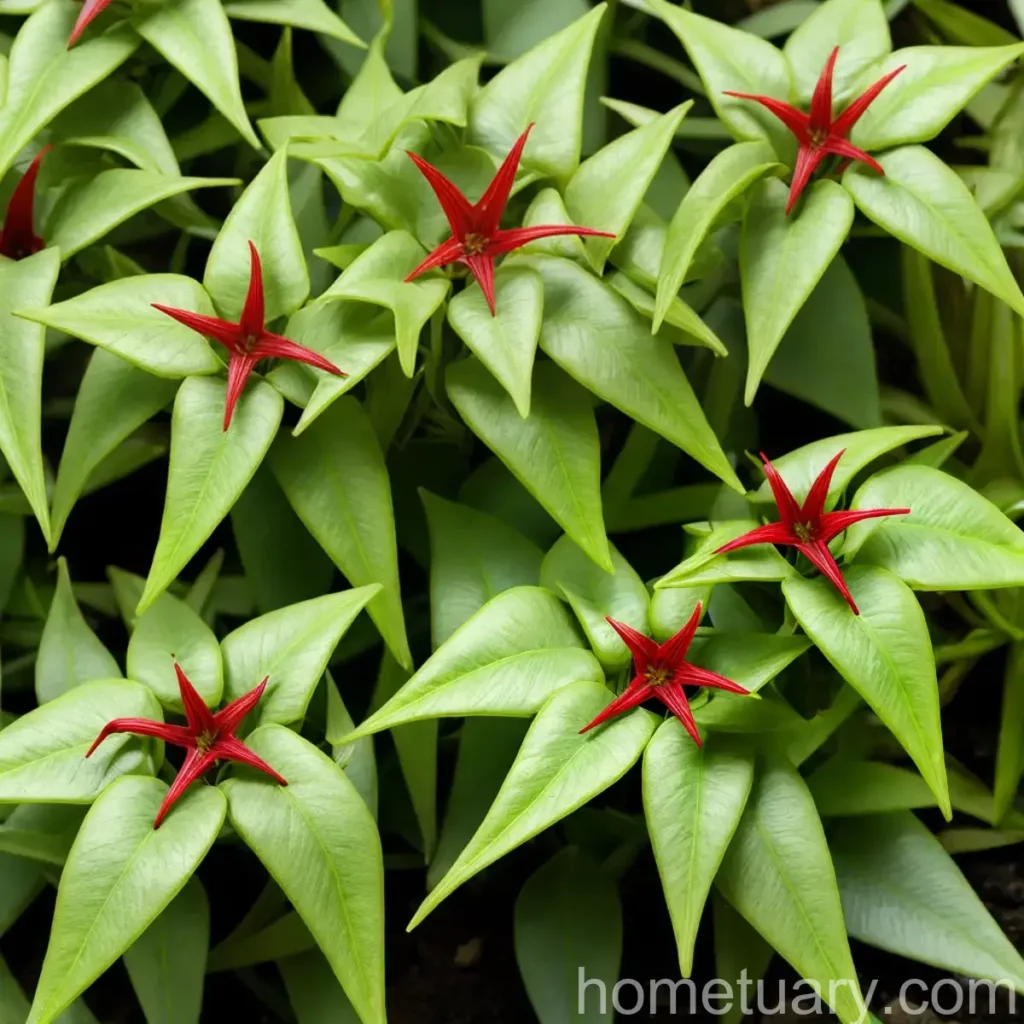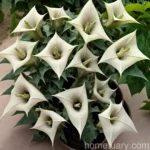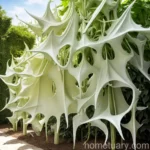The Matrimony Vine (Lycium barbarum): A Comprehensive Guide
The Matrimony vine, scientifically known as Lycium barbarum, is a fascinating and versatile plant that has been used for centuries in traditional medicine, culinary preparations, and ornamental landscaping. Its adaptable nature, coupled with its numerous health benefits and aesthetic appeal, has made it a popular choice for plant enthusiasts and researchers alike. In this comprehensive guide, we will explore the various facets of the Matrimony vine, from its cultural requirements and propagation methods to its uses, folklore, and ecological importance. Join me as we delve into the intricate world of the Matrimony vine and uncover the hidden treasures it holds.
What is the Matrimony Vine (Lycium barbarum)?
The Matrimony vine, also known as Goji berry, Chinese wolfberry, or simply Lycium, is a woody perennial plant native to the temperate and subtropical regions of China, Mongolia, and the Himalayas. It belongs to the family Solanaceae, which includes other well-known members such as tomatoes, potatoes, and eggplants. The plant is characterized by its sprawling growth habit, delicate flowers, and vibrant red berries that are often considered a superfood due to their high nutritional value.
Key Takeaways – Matrimony Vine (Lycium barbarum)
Before we delve into the intricate details of the Matrimony vine, let’s take a look at the key takeaways that we’ll be exploring throughout this guide:
-
Matrimony vine uses: Understanding the various applications of the plant in traditional medicine, culinary practices, and landscaping.
-
Lycium barbarum benefits: Uncovering the numerous health benefits and nutritional value of the plant.
-
Matrimony vine plant care: Exploring the cultural requirements, including water, sunlight, fertilizer, soil, and pruning.
-
Lycium barbarum growth habits: Understanding the growth patterns and adaptability of the plant.
-
Matrimony vine health benefits: Diving deeper into the medicinal uses and antioxidant properties of the Matrimony vine.
-
Lycium barbarum cultivation tips: Providing expert tips for successfully cultivating and caring for the plant.
-
Matrimony vine propagation methods: Exploring the various techniques for propagating the Matrimony vine.
-
Lycium barbarum medicinal uses: Understanding the traditional and modern medicinal applications of the plant.
-
Matrimony vine pruning techniques: Learning the best practices for pruning and shaping the plant.
-
Lycium barbarum antioxidant properties: Uncovering the antioxidant-rich nature of the plant and its implications for human health.
-
Matrimony vine in traditional medicine: Exploring the historical and cultural significance of the plant in traditional medicine.
-
Lycium barbarum soil requirements: Understanding the soil preferences and requirements of the Matrimony vine.
-
Matrimony vine pest control: Identifying common pests and diseases that affect the plant and effective control measures.
-
Lycium barbarum nutritional value: Uncovering the nutritional composition and value of the Matrimony vine.
-
Matrimony vine as a superfood: Exploring the superfood status of the plant and its culinary applications.
-
Lycium barbarum flowering season: Understanding the flowering patterns and seasonality of the plant.
-
Matrimony vine herbal remedies: Exploring traditional herbal remedies and preparations using the plant.
-
Lycium barbarum water requirements: Understanding the watering needs and preferences of the Matrimony vine.
-
Matrimony vine wildlife benefits: Exploring the ecological importance of the plant as a habitat and food source for wildlife.
-
Lycium barbarum adaptability: Understanding the adaptability and resilience of the plant to various environmental conditions.
-
Matrimony vine for landscaping: Exploring the ornamental uses and landscaping potential of the Matrimony vine.
-
Lycium barbarum drought tolerance: Understanding the plant’s ability to tolerate drought conditions.
-
Matrimony vine folklore and myths: Uncovering the folklore, myths, and cultural significance associated with the plant.
-
Lycium barbarum leaf characteristics: Exploring the unique characteristics of the plant’s leaves.
-
Matrimony vine growing conditions: Understanding the optimal growing conditions for the Matrimony vine.
-
Lycium barbarum propagation techniques: Exploring the various methods for propagating the plant.
-
Matrimony vine traditional uses: Understanding the historical and traditional uses of the plant.
-
Lycium barbarum bloom color: Exploring the vibrant colors and aesthetics of the plant’s blooms.
-
Matrimony vine pests and diseases: Identifying common pests and diseases that affect the plant and effective control measures.
-
Lycium barbarum climate preferences: Understanding the plant’s preferences for specific climatic conditions.
-
Matrimony vine farming practices: Exploring commercial farming practices and cultivation techniques.
-
Lycium barbarum pruning frequency: Understanding the frequency and best practices for pruning the plant.
-
Matrimony vine herbal tea recipe: Exploring the culinary applications and herbal tea recipes using the plant.
-
Lycium barbarum fruit harvesting: Understanding the techniques and timing for harvesting the plant’s fruits.
-
Matrimony vine historical significance: Uncovering the historical significance and cultural importance of the plant.
-
Lycium barbarum seed germination: Exploring the methods and requirements for successful seed germination.
-
Matrimony vine landscape design: Understanding the design and ornamental uses of the Matrimony vine in landscaping.
-
Lycium barbarum culinary uses: Exploring the culinary applications and uses of the plant’s fruits.
-
Matrimony vine sun exposure: Understanding the plant’s preferences for sunlight and sun exposure.
-
Lycium barbarum container gardening: Exploring the cultivation of the plant in containers and confined spaces.
-
Matrimony vine traditional beliefs: Uncovering the traditional beliefs and cultural significance associated with the plant.
-
Lycium barbarum trellis support: Understanding the plant’s potential for growing on trellises and support structures.
-
Matrimony vine wildlife habitat: Exploring the ecological importance of the plant as a wildlife habitat.
-
Lycium barbarum native distribution: Understanding the native distribution and natural habitat of the plant.
-
Matrimony vine appearance: Uncovering the physical appearance and characteristics of the Matrimony vine.
-
Lycium barbarum leaf arrangement: Exploring the unique leaf arrangement and structure of the plant.
-
Matrimony vine pruning season: Understanding the optimal season for pruning the plant.
-
Lycium barbarum companion plants: Identifying suitable companion plants and species to grow alongside the Matrimony vine.
-
Matrimony vine climate suitability: Understanding the plant’s suitability for specific climatic conditions.
-
Lycium barbarum flowering patterns: Exploring the beautiful and intricate flowering patterns displayed by the plant.
Now that we have a comprehensive overview of the key takeaways, let’s delve deeper into each aspect of the Matrimony vine, from its cultural requirements and cultivation to its uses and ecological significance.
Culture
Water
The Matrimony vine thrives in well-draining soil and prefers regular moisture, especially during its active growth period. Adequate watering is essential for ensuring healthy growth and robust berry production. However, the plant is also tolerant of drought conditions once established, making it an ideal choice for xeriscaping and water-wise gardening. When watering the Matrimony vine, it is important to strike a balance to avoid waterlogging, which can lead to root rot and other issues.
Sunlight
Like most plants, the Matrimony vine requires ample sunlight to thrive and produce an abundant harvest of vibrant berries. It prefers full sun and can tolerate partial shade, especially in hotter climates where some degree of afternoon shade can be beneficial. When selecting a planting site for the Matrimony vine, it is important to consider the availability of sunlight throughout the day and ensure that the plant receives at least 6-8 hours of direct sunlight for optimal growth.
Fertilizer
Proper fertilization is essential for promoting healthy growth and maximizing fruit production in the Matrimony vine. A balanced, slow-release fertilizer formulated for fruiting plants can be applied in early spring as the plant begins its active growth phase. Additionally, organic compost and well-rotted manure can be incorporated into the soil to provide a steady supply of nutrients. Care should be taken to avoid excessive nitrogen, as this can lead to excessive vegetative growth at the expense of fruit production.
Soil
The Matrimony vine thrives in well-draining, slightly acidic to neutral soil with a pH range of 6.0-7.0. Rich, loamy soils with good organic matter content are particularly beneficial for promoting vigorous growth and ensuring adequate moisture retention without waterlogging. Prior to planting, a soil test can be conducted to assess the pH and nutrient levels of the soil, allowing for targeted amendments as needed. Additionally, mulching with organic materials can help maintain soil moisture and suppress weed growth around the base of the plant.
Pruning
Pruning plays a crucial role in shaping the growth of the Matrimony vine, promoting fruiting wood, and maintaining an open, airy canopy that facilitates air circulation and sunlight penetration. In late winter or early spring, dormant pruning can be carried out to remove dead, damaged, or crossing branches, as well as to shape the plant and encourage lateral growth. Additionally, selective thinning of the canopy can help reduce overcrowding and improve the overall health of the vine.
Uses
Medicinal Uses
The Matrimony vine has a rich history of traditional medicinal uses, particularly in Chinese medicine, where it is revered for its therapeutic properties and health benefits. The berries and other parts of the plant are known for their antioxidant, anti-inflammatory, and immune-boosting properties, making them valuable ingredients in herbal preparations and tonics. From supporting vision and eye health to improving immune function and promoting longevity, the Matrimony vine has been cherished for its diverse medicinal benefits.
Culinary Uses
In addition to its medicinal value, the berries of the Matrimony vine are prized for their culinary versatility and nutritional richness. They can be enjoyed fresh, dried, or in various processed forms, adding a sweet-tart flavor and a nutritional boost to a wide range of dishes and beverages. From teas and smoothies to baked goods, soups, and sauces, the berries can be incorporated into an array of culinary creations, offering a burst of vibrant color and essential nutrients.
Propagation
The Matrimony vine can be propagated through various methods, including seeds, cuttings, and division. Each method offers its own unique advantages and challenges, allowing plant enthusiasts and commercial growers to propagate the plant according to their specific needs and preferences. Understanding the propagation techniques and requirements can help ensure successful establishment and propagation of the Matrimony vine.
Seed Propagation
Propagating the Matrimony vine from seeds offers a cost-effective and straightforward method for generating new plants. The seeds can be collected from mature berries and either sown directly in the ground or started indoors in seed trays. Scarification of the seeds, either through mechanical or chemical treatment, can aid in breaking the seed coat and promoting germination. A well-draining seed starting mix and consistent moisture are essential for successful seed germination and establishment.
Cutting Propagation
The Matrimony vine can also be propagated from semi-hardwood cuttings taken during the active growing season. Selecting healthy, disease-free stems with several nodes and removing the lower leaves can promote successful rooting. The cuttings can be treated with a rooting hormone to encourage root development and placed in a well-draining propagation medium. A warm, humid environment and regular misting can aid in rooting, and careful monitoring of the cuttings is essential to ensure their successful establishment.
Division
For mature Matrimony vines, division offers a straightforward method for propagating the plant and rejuvenating older specimens. The plant can be carefully dug up, and the root mass divided into several sections, each with its own stems and root system. This method is particularly useful for controlling the size of the plant and generating new specimens from established parent plants. Additionally, division can help improve the overall health and vigor of older Matrimony vines.
Popularity
The growing popularity of the Matrimony vine can be attributed to several key factors, including its ornamental appeal, culinary and medicinal value, and adaptability to diverse growing conditions. As a plant that offers both aesthetic beauty and practical utility, it has captured the attention of home gardeners, horticulturists, and researchers alike. Its widespread popularity is a testament to its enduring charm and the numerous benefits it offers to those who cultivate and appreciate it.
Container Cultivation
One of the reasons for the widespread popularity of the Matrimony vine is its suitability for container cultivation. The plant’s compact size, moderate growth rate, and adaptability to confined spaces make it an ideal candidate for growing in containers on patios, balconies, and urban gardens. When provided with adequate sunlight, well-draining soil, and regular moisture, the Matrimony vine can thrive in containers, producing an abundant harvest of berries and adding a touch of natural beauty to outdoor living spaces.
Culinary and Medicinal Value
The nutritional richness and medicinal properties of the Matrimony vine have contributed to its growing popularity as a valuable addition to home gardens, herbal apothecaries, and commercial orchards. With an increasing focus on natural health and wellness, the plant’s antioxidant-rich berries have gained recognition for their role in supporting overall well-being and enhancing culinary creations. The ability to enjoy the plant’s fruits fresh or in processed forms has further bolstered its appeal to a wide audience.
Ornamental Appeal
In addition to its practical uses, the Matrimony vine also captivates enthusiasts with its ornamental charm, including delicate flowers, vibrant berries, and gracefully arching stems. Its ability to thrive in diverse landscapes, whether as a standalone specimen, hedgerow, or trellised vine, has made it a popular choice for adding color and texture to gardens, parks, and public spaces. The plant’s adaptability to various soil types and climates further enhances its ornamental value and makes it a versatile addition to landscapes.
Common Diseases and Pests
Like all plants, the Matrimony vine is susceptible to certain diseases and pests that can affect its health and productivity. Understanding the common issues that may arise and implementing proactive measures can help protect the plant and ensure its long-term vitality. From fungal infections and nutritional deficiencies to insect infestations, vigilance and prompt intervention are crucial for maintaining the health of the Matrimony vine.
Disease Diagnosis
Fungal diseases, including powdery mildew, root rot, and leaf spot, are among the most common issues that can affect the Matrimony vine. Proper diagnosis and timely treatment are essential for managing these diseases and preventing their spread. Regular inspection of the plant for signs of discoloration, wilting, or abnormal growth can help identify potential issues early on and guide targeted intervention. Additionally, ensuring proper air circulation, soil drainage, and plant nutrition can help minimize the risk of fungal diseases.
Common Pests
Numerous pests can pose a threat to the health of the Matrimony vine, including aphids, spider mites, and scale insects. These pests can cause damage to the foliage, weaken the plant, and reduce fruit production if left unchecked. Integrated pest management (IPM) strategies, such as biological controls, botanical insecticides, and horticultural oils, can be employed to manage pest populations and minimize their impact on the plant. Regular monitoring and early intervention are key to preventing pest infestations from escalating.
Botanist’s Tips
As a plant scientist and enthusiast, I have had the privilege of studying and cultivating the Matrimony vine, and I am delighted to share some expert tips for successfully caring for this remarkable plant. These tips are drawn from both scientific knowledge and practical experience, providing valuable insights for those who wish to bring out the best in their Matrimony vines.
Fun Facts
Before we conclude our exploration of the Matrimony vine, let’s take a moment to appreciate some fun and intriguing facts about this extraordinary plant:
- The Matrimony vine has been cultivated for over 2,000 years in Asia and holds a revered place in traditional Chinese medicine and cultural practices.
- The vibrant red berries of the Matrimony vine are packed with essential nutrients, including vitamins A and C, antioxidants, and amino acids, making them a valuable functional food.
- The plant’s delicate flowers attract pollinators, including bees and butterflies, contributing to the ecological diversity and health of local ecosystems.
- In addition to its medicinal and culinary uses, the Matrimony vine has been featured in landscape designs and ornamental gardens for its striking appearance and low-maintenance nature.
Links to External Resources
To further enrich your understanding of the Matrimony vine and explore additional resources, I have curated a selection of valuable links that provide in-depth information, advice, and inspiration related to this remarkable plant:
- University of Maryland Medical Center: Goji Berry
- Royal Horticultural Society: Lycium barbarum
- USDA Plant Guide: Lycium barbarum
- NC State Extension: Goji Berry Production
- Missouri Botanical Garden: Lycium barbarum
- Plant Physiology: Antioxidant and Antitumor Activities of Lycium barbarum Polysaccharides Production
With these resources at your disposal, you can embark on a deeper exploration of the Matrimony vine, uncovering its mysteries and unlocking its potential in various domains, from health and wellness to horticulture and ecological stewardship.
In conclusion, the Matrimony vine (Lycium barbarum) stands as a remarkable example of nature’s bounty, offering a tapestry of uses, benefits, and cultural significance that transcend time and geographical boundaries. From its rich historical ties to traditional medicine to its modern-day applications in culinary creations and landscape design, the plant continues to captivate and inspire those who seek to cultivate its potential. As we continue our journey through the intricate world of plants, let us carry with us the lessons and insights gained from the awe-inspiring Matrimony vine, embracing its wisdom and beauty as we tread the path of botanical discovery.















